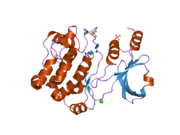PAK6
Ensembl | |||||||||
|---|---|---|---|---|---|---|---|---|---|
| UniProt | |||||||||
| RefSeq (mRNA) | |||||||||
| RefSeq (protein) | |||||||||
| Location (UCSC) | Chr 15: 40.22 – 40.28 Mb | Chr 2: 118.49 – 118.53 Mb | |||||||
| PubMed search | [3] | [4] | |||||||
| View/Edit Human | View/Edit Mouse |
Serine/threonine-protein kinase PAK 6 is an enzyme that in humans is encoded by the PAK6 gene.[5][6]
PAK6 belongs to the Group II PAK family members.[7] Like other family members, PAK6 is also evolutionary conserved across species.[8]
Discovery
The PAK6 was originally cloned as an androgen receptor interacting kinase which can be stimulated by androgen receptor but not Rac or Cdc42, like other family members.[7]
Gene and spliced variants
The human PAK6 gene consists of 16 exons of which 8 exons are used for 5’-UTR splicing to generating 17 transcripts by alternative splicing, and the gene is about 38-kb long. Among PAK6 transcripts, 14 are protein coding RNAs to code four proteins of 681 and 636 amino acids while remaining PAK6 transcripts are non-coding RNAs. There are five transcripts in murine PAK6 gene, of which two transcripts are protein coding and other two non-coding RNAs(Gene from review).
Protein domains
Following the general structural organization of the group II PAKs, PAK6 also contains a kinase, and a GTPase interacting domain.[9][10]
Function
This gene encodes a protein that shares a high degree of sequence similarity with p21-activated kinase (PAK) family members. The proteins of this family are Rac/Cdc42-associated Ste20-like Ser/Thr protein kinases, characterized by a highly conserved amino-terminal Cdc42/Rac interactive binding (CRIB) domain and a carboxyl-terminal kinase domain. PAK kinases are implicated in the regulation of a number of cellular processes, including cytoskeleton rearrangement, apoptosis and the MAP kinase signaling pathway. The protein encoded by this gene was found to interact with androgen receptor (AR), which is a steroid hormone-dependent transcription factor that is important for male sexual differentiation and development. The p21-activated protein kinase 6 gene was found to be highly expressed in testis and prostate tissues and the encoded protein was shown to cotranslocate into the nucleus with AR in response to androgen.[6]
Genetic deletion of PAK6 alone in mice leads to increased body mass.[11] However, PAK6 deletion along with PAK5 impairs the ability of animals to learn and move.[11][12] PAK6 expression is increased in a rat model of spinal cord injury.[13] PAK6 is also considered a candidate gene for epileptic encephalopathy,[14] and interacts with Parkinson associated gene product leucine-rich repeat kinase 2.[15] PAK6 expression has been found to be overexpressed in prostate cancer,[16][17] hepatocellular carcinoma,[18] and colon cancer.[19] PAK6 levels have been correlated well with therapeutic resistance to 5-flurouracil,[19] docetaxel,[17] and radiation.[20]
Regulators and interactors
PAK6 kinase activity is positively regulated by androgen receptor,[7][21] p38MAPK,[22] 5-fluorouracil[19] and atypical Rho family GTPase Chp/RhoV.[23] PAK6 expression is negatively regulated by miR-328, miR-429 and miR-23a.[24][25][26] PAK6 interacts with junctional protein IQGAP1,[27][28] E3 ligase Mdm2,[29] and leucine-rich repeat kinase 2 (LRRK2).[15]
Interactions
PAK6 has been shown to
Notes
Wikidata Q38779105 . |
References
- ^ a b c GRCh38: Ensembl release 89: ENSG00000137843 – Ensembl, May 2017
- ^ a b c GRCm38: Ensembl release 89: ENSMUSG00000074923 – Ensembl, May 2017
- ^ "Human PubMed Reference:". National Center for Biotechnology Information, U.S. National Library of Medicine.
- ^ "Mouse PubMed Reference:". National Center for Biotechnology Information, U.S. National Library of Medicine.
- ^ PMID 11278661.
- ^ a b "Entrez Gene: PAK6 p21(CDKN1A)-activated kinase 6".
- ^ PMID 11773441.
- PMID 19350548.
- )
- PMID 26811660.
- ^ PMID 23593460.
- PMID 18675265.
- S2CID 23042073.
- PMID 27066588.
- ^ PMID 26375402.
- S2CID 12959176.
- ^ PMID 19362342.
- PMID 24576777.
- ^ PMID 25426562.
- PMID 20054820.
- PMID 24130878.
- PMID 15550393.
- S2CID 16567426.
- PMID 26459798.
- PMID 26058485.
- PMID 25714010.
- PMID 24352566.
- PMID 26598554.
- PMID 23132866.


